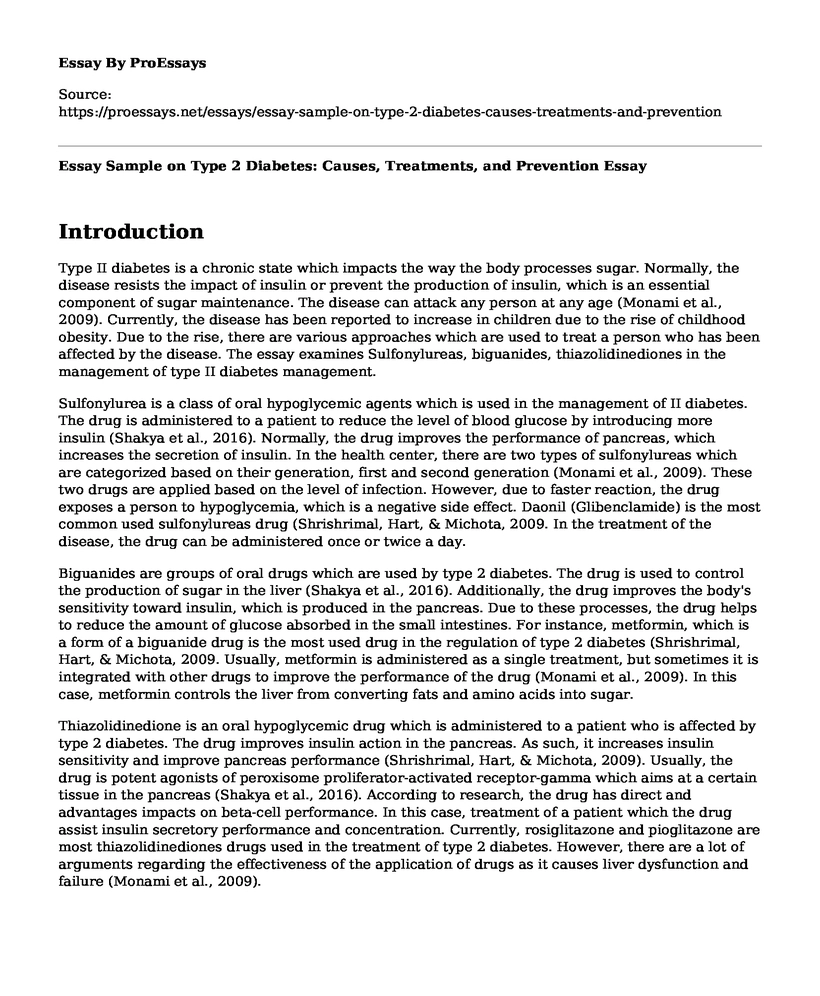Introduction
Type II diabetes is a chronic state which impacts the way the body processes sugar. Normally, the disease resists the impact of insulin or prevent the production of insulin, which is an essential component of sugar maintenance. The disease can attack any person at any age (Monami et al., 2009). Currently, the disease has been reported to increase in children due to the rise of childhood obesity. Due to the rise, there are various approaches which are used to treat a person who has been affected by the disease. The essay examines Sulfonylureas, biguanides, thiazolidinediones in the management of type II diabetes management.
Sulfonylurea is a class of oral hypoglycemic agents which is used in the management of II diabetes. The drug is administered to a patient to reduce the level of blood glucose by introducing more insulin (Shakya et al., 2016). Normally, the drug improves the performance of pancreas, which increases the secretion of insulin. In the health center, there are two types of sulfonylureas which are categorized based on their generation, first and second generation (Monami et al., 2009). These two drugs are applied based on the level of infection. However, due to faster reaction, the drug exposes a person to hypoglycemia, which is a negative side effect. Daonil (Glibenclamide) is the most common used sulfonylureas drug (Shrishrimal, Hart, & Michota, 2009. In the treatment of the disease, the drug can be administered once or twice a day.
Biguanides are groups of oral drugs which are used by type 2 diabetes. The drug is used to control the production of sugar in the liver (Shakya et al., 2016). Additionally, the drug improves the body's sensitivity toward insulin, which is produced in the pancreas. Due to these processes, the drug helps to reduce the amount of glucose absorbed in the small intestines. For instance, metformin, which is a form of a biguanide drug is the most used drug in the regulation of type 2 diabetes (Shrishrimal, Hart, & Michota, 2009. Usually, metformin is administered as a single treatment, but sometimes it is integrated with other drugs to improve the performance of the drug (Monami et al., 2009). In this case, metformin controls the liver from converting fats and amino acids into sugar.
Thiazolidinedione is an oral hypoglycemic drug which is administered to a patient who is affected by type 2 diabetes. The drug improves insulin action in the pancreas. As such, it increases insulin sensitivity and improve pancreas performance (Shrishrimal, Hart, & Michota, 2009). Usually, the drug is potent agonists of peroxisome proliferator-activated receptor-gamma which aims at a certain tissue in the pancreas (Shakya et al., 2016). According to research, the drug has direct and advantages impacts on beta-cell performance. In this case, treatment of a patient which the drug assist insulin secretory performance and concentration. Currently, rosiglitazone and pioglitazone are most thiazolidinediones drugs used in the treatment of type 2 diabetes. However, there are a lot of arguments regarding the effectiveness of the application of drugs as it causes liver dysfunction and failure (Monami et al., 2009).
Conclusion
In conclusion, treatment of type 2 diabetes has assisted in the reduction of the effects. Drugs such as Sulfonylureas, biguanides, thiazolidinediones are used in the management of the disease. These drugs try to regulate the production of insulin and the level of blood sugar. However, these drugs are associated with some negative effects such as liver failure.
References
Monami, M., Lamanna, C., Balzi, D., Marchionni, N., & Mannucci, E. (2009). Sulphonylureas and cancer: a case-control study. Acta diabetologica, 46(4), 279. Retrieved from https://flore.unifi.it/retrieve/handle/2158/606389/18758/Monami_Acta%20Diabetologica%202009.pdf.
Shakya, S., Bajracharya, S., Shakya, A., Shakya, S., Chaudhary, S., Gautam, S., & Shankar, R. (2016). Comparative Study on Dual and Triple Therapy Using Oral Antidiabetic Drugs in Treatment of Type 2 Diabetes Mellitus. Journal of Advanced Academic Research, 3(2), 128-137. Retrieved from https://www.nepjol.info/index.php/JAAR/article/download/16761/13625.
Shrishrimal, K., Hart, P., & Michota, F. (2009). Managing diabetes in hemodialysis patients: observations and recommendations. Cleve Clin J Med, 76(11), 649-655. Retrieved from https://mdedge-files-live.s3.us-east-2.amazonaws.com/files/s3fs-public/issues/articles/media_b5e6e1a_649.pdf.
Cite this page
Essay Sample on Type 2 Diabetes: Causes, Treatments, and Prevention. (2023, Jan 31). Retrieved from https://proessays.net/essays/essay-sample-on-type-2-diabetes-causes-treatments-and-prevention
If you are the original author of this essay and no longer wish to have it published on the ProEssays website, please click below to request its removal:
- Issues in Social Work
- Nursing Informatics Quality Improvement Plan - Essay Example
- Abortion and Moral Theory
- Total Communication as a Method of Education for Children With Disabilities Essay
- Company: Microsoft Corporation
- New Grad Nurses: Challenges & Solutions in Healthcare Transition - Research Paper
- Essay Example on Sampling Theory & Generalizability in Nursing Research







